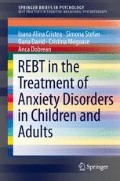Abstract
Anxiety is transmitted from parents to children both genetically and environmentally (Creswell, Murray, Stacey, & Cooper, 2011). On the one hand, biologic vulnerability to anxiety explains up to 30–40 % of anxiety variability, while environmental factors account for the rest (Barlow, 2002). On the other hand, the way parents conduct exposure to the environment, the way they react to new, uncertain, or ambiguous stimuli, and the reinforcements and punishments they apply, all can model anxious emotional responses and behaviors. While inborn personality features such as neuroticism favor anxious responses, fear is learned in the environment, and there are several mechanisms which can explain how a child learns to be afraid of particular stimuli and situations:
Access this chapter
Tax calculation will be finalised at checkout
Purchases are for personal use only
Notes
- 1.
Based on the information obtained during the assessment phase.
References
Bandura, A. (Ed.). (1977). Social learning theory. Englewood Cliffs, NJ: Prentice-Hall.
Barlow, D. H. (2002). Anxiety and its disorders: The nature and treatment of anxiety and panic (2nd ed.). New York: Guilford.
Beck, A. T. (1976). Cognitive therapy and the emotional disorders. New York: International Universities Press.
Bernard, M. E., & Joyce, M. R. (1984). Rational emotive therapy with children and adolescents. New York: Wiley.
Cartwright-Hatton, S., Roberts, C., Chitsabesan, P., Fothergill, C., & Harrington, R. (2004). Systematic review of the efficacy of cognitive behaviour therapies for childhood and adolescent anxiety disorders. British Journal of Clinical Psychology, 43, 421–436.
Clark, D. A., & Beck, A. T. (2010). Cognitive therapy of anxiety disorders. Science and practice. New York: Guilford.
Creswell, C., Murray, L., Stacey, J., & Cooper, P. (2011). Parenting and child anxiety. In W. K. Silverman & A. P. Field (Eds.), Anxiety disorders in children and adolescents (2nd ed.). Cambridge, England: Cambridge Child and Adolescent Psychiatry, Cambridge University Press.
DiGiuseppe, R., & Bernard, M. (2006). REBT assessment and treatment with children. In A. Ellis & M. Bernard (Eds.), Rational emotive behavioral approaches to childhood disorders. Theory, practice, and research (pp. 85–114). New York: Springer.
Ellis, A. (1994). Reason and emotion in psychotherapy (Rev. ed.). Secaucus, NJ: Birch Lane.
Ellis, A. (1982). Psychoneurosis and anxiety problems. In R. Grieger and I. Grieger’s (eds.), Cognition and emotional disturbance. New York: Human Sciences Press.
Ellis, A. & Bernard, M. (2006). Rational emotive behavioral approaches to childhood disorders (Theory, practice, and research). New York: Springer.
Iftene, F., Predescu, E., Stefan, S., & David, D. (2015). Rational-emotive and cognitive-behavior therapy (REBT/CBT) versus pharmacotherapy versus REBT/CBT plus pharmacotherapy in the treatment of major depressive disorder in youth; A randomized clinical trial. Psychiatry Research, 225(3), 687–692.
James, A. C., James, G., Cowdrey, F. A., Soler, A., & Choke, A. (2013). Cognitive behavioural therapy for anxiety disorders in children and adolescents. Cochrane Database of Systematic Reviews, (6), CD004690.
James, A., Soler, A., & Weatherall, R. (2005). Cognitive behavioural therapy for anxiety disorders in children and adolescents. Cochrane Database of Systematic Reviews, (4), CD004690.
Kendall, P. C. (1994). Treating anxiety disorders in children: Results of a randomized clinical trial. Journal of Consulting and Clinical Psychology, 62(1), 100–110.
Kendall, P. C., & Southam-Gerow, M. A. (1996). Long-term follow-up of a cognitive-behavioral therapy for anxiety-disordered youth. Journal of Consulting and Clinical Psychology, 64(4), 724–730.
March, J., Parker, J., Sullivan, K., Stallings, P., & Conners, C. (1997). The Multidimensional Anxiety Scale for Children (MASC): Factor structure, reliability and validity. Journal of the American Academy of Child and Adolescent Psychiatry, 36, 554–565.
Marshall, T., & Ramchandani, T. (2008). Emotional disorders in children and adolescents. Medicine, 36(9), 478–481.
Shortt, A. L., Barrett, P. M., & Fox, T. L. (2001). Evaluating the FRIENDS program: A cognitive-behavioral group treatment for anxious children and their parents. Journal of Child Clinical Psychology, 30(4), 525–535.
Silverman, W. K., & Motoca, L. M. (2011). Treatment: An update and recommendations. In W. K. Silverman & A. P. Field (Eds.), Anxiety disorders in children and adolescents (2nd ed.). New York: Cambridge University Press.
Silverman, W. K., Pina, A. A., & Viswesvaran, C. (2008). Evidence-based psychosocial treatments for phobic and anxiety disorders in children and adolescents. Journal of Clinical Child and Adolescent Psychology, 37, 105–130.
Skinner, B. F. (1974). About behaviorism. New York: Random House.
Spence, S. H. (1998). A measure of anxiety symptoms among children. Behavior Research and Therapy, 36, 545–566.
Wagner, K. D., Ambrosini, P., Rynn, M., Wohlberg, C., Yang, R., Greenbaum, M. S., et al. (2003). Efficacy of sertraline in the treatment of children and adolescents with major depressive disorder. Two randomized controlled trials. The Journal of the American Medical Association, 290(8), 103–1041.
Watson, J. B., & Rayner, R. (1920). Conditioned emotional reactions. Journal of Experimental Psychology, 3, 1–14.
Woulff, N. (1983). Involving the family in the treatment of the child: A model for rational-emotive therapists. In A. Ellis & M. E. Bernard (Eds.), Rational-emotive approaches to the problems of childhood. New York: Plenum Press.
Acknowledgments
This chapter was funded by the Romanian Executive Unit for Financing Education Higher Research, Development and Innovation (UEFISCDI) via the “Effectiveness of an empirically based web platform for anxiety in youths” grant, number PN-II-PT-PCCA-2011-3.1-1500, 81/2012 coordinated by Dr. Anca Dobrean.
Author information
Authors and Affiliations
Rights and permissions
Copyright information
© 2016 The Author(s)
About this chapter
Cite this chapter
Cristea, I.A., Stefan, S., David, O., Mogoase, C., Dobrean, A. (2016). Rational-Emotive and Cognitive-Behavior Therapy (RE&BT) Treatment Protocol for Anxiety in Children and Adolescents. In: REBT in the Treatment of Anxiety Disorders in Children and Adults. SpringerBriefs in Psychology(). Springer, Cham. https://doi.org/10.1007/978-3-319-18419-7_4
Download citation
DOI: https://doi.org/10.1007/978-3-319-18419-7_4
Publisher Name: Springer, Cham
Print ISBN: 978-3-319-18418-0
Online ISBN: 978-3-319-18419-7
eBook Packages: Behavioral Science and PsychologyBehavioral Science and Psychology (R0)

